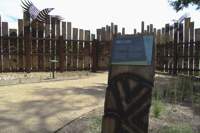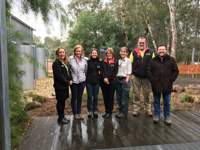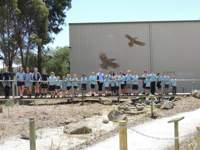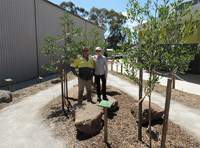Projects - Taungurung Clans
Mending Mountains for the Pygmy-Possum project
Taungurung Land and Waters Council are working with Goulburn Broken CMA, Australian scientists and land managers to prevent extinction of the endangered mountain pygmy possum from the boulder fields at Mount Buller. This tiny possum was first discovered at Mount Buller in 1996, and only occurs at three locations in the world (Mount Buller, Mount Kosciusko and Mount Hotham). When it was discovered at Mount Buller, the population was recorded to be around 300 animals. Since then, numbers have decreased significantly due to feral cat and fox predation, habit degradation and fragmentation, decline in key food resources, and loss of genetic diversity due to the small population.
Ecologists have been working with land managers since 1996 to relocate animals from other areas, which has improved the trajectory of the mountain pygmy-possum population. Through the Mending Mountains for the Pygmy-possum Project Goulburn Broken CMA and Taungurung Land and Waters Council are working with land managers to address threats to the mountian pygmy-possum through on-ground works including weed control, revegetation and Bogong moth (a key food source) monitoring activities. Taungurung Land and Waters Council are also assisting ecologist Dean Heinze to monitor the numbers and health of the existing population, and have undertaken surveys at Mount Howitt to search for possible other populations.
The Mountain Pygmy-possum is listed as an endangered species under the Environment Protection and Biodiversity Act (EPBC). The Mending Mountains for Pygmy Possums project delivers on actions within the National Recovery Plan for this species, and is supported by Goulburn Broken CMA through funding from the Australian Government’s National Landcare Program.
Yea Wetlands and the Badji Baanang Indigenous Garden

_200.jpg)

The Yea wetlands are an important site for Taungurung people and the Franklin Track (named after Taungurung man and Yea resident John Franklin) has been developed within the wetlands. The walking track includes a summary of key stories of how the Taungurung people used and valued the natural assets of the Yea region's waterways and wetlands.
The Badji Baanang Indigenous Garden at the Y Wetlands Discovery Centre at Yea was officially opened in November 2017. The garden, which was funded through the Australian Government's National Landcare Program, was a collaborative effort between the Goulburn Broken CMA and Taungurung Clans. It was designed by Karen Sutherland from Edible Eden Design and is planted with a range of plants commonly used by Taungurung people for food, medicine and cultural purposes. Signs list the plants’ names in Taungurung language, and information on how they were used by the Traditional Owners. Taungurung women Angela Ten Buuren and Lee Healy provided information on the plants and language. Staff from Eden Edible Design, Murrindindi Shire Council and the Green Army and Taungurung Land and Waters Council’s Shane Monk helped with the planting. Taungurung’s Mick Harding and Cassie Leatham created the artwork on the garden’s fence, which features Taungurung’s two totems Bundjil (wedge-tailed eagle) and Waang (crow).
This garden and interpretive information about the region's Traditional Owners recognises and raises awareness of Taungurung Clans’ intrinsic, ongoing connection to Country, and creates even more interest in the important tourist attraction at the Y Wetlands Discovery Centre.
Seymour Taungurung Indigenous Garden


The Seymour College Taungurung Indigenous Garden was opened in October 2015. The garden is a collaborative project between Seymour College, Taungurung Land and Waters Council and the Goulburn Broken CMA. The project was made possible through a funding from the Nestle Community Environment Program and the Australian Government's National Landcare Program. The project was also made possible through volunteer David Stute (President of Parents Club) who built infrastructure for the garden and helped oversee the project.
The garden was designed to raise awareness of the Taungurung people as the Traditional Owners of the region, and incorporates a variety of plants that are culturally important to Taungurung people. The garden provides a teaching centre for Taungurung Elders to spend time with the students, to teach them about Taungurung culture and the importance of caring for country.
The garden design replicates a dry creek as an effective and practical way to address erosion, and to deal with excess runoff from what was a sloping degraded area of the school grounds. The impact that vegetation has on our waterways is also demonstrated as the garden and creek bed are designed to slow the water flow across the College and prevent flooding that has occurred in adjacent buildings.
The garden also incorporates information about Indigenous plants and the species that depend on these plants for survival, including local birds and butterflies, and incorporates a frog pond to demonstrate the importance of clean water and riparian vegetation in providing suitable habitat for frogs.
‘'The project has strengthened Taungurung's relationship with the Goulburn Broken CMA as well as our partnership with Seymour College. It demonstrates that cultural and environmental elements can be included in a way that encourages Aboriginal students to recognise their cultural heritage." - Lawrence Moser.
Alpine Bog Project
Alpine Bog is a rare vegetation community listed at a state level under the Flora and Fauna Guarantee Act (FFG), and at a Federal level under the Environment Protection and Biodiversity Act (EPBC). There are approximately 4500 hectares of this important vegetation type in the Victorian Alps, and considerable work is being undertaken by various agencies to protect it from a range of threats, including (but not limited to) infrastructure and development, invasive plants and animals, livestock, recreational use and inappropriate fire regimes.
Taungurung Clans have been working with the Goulburn Broken CMA and appropriate land managers to undertake weed control works - primarily willows and blackberry - in these sensitive wetland areas since 2010. This has included a mapping and assessment project undertaken with Arthur Rylah Institute (Arn Tolsma) to assess and document the current condition and extent of bogs within the catchment. As well as providing a guiding document for ongoing works, the mapping and assessment project also provided Taungurung members with valuable skills in identifying wetland plants and assessing bog condition.
Through the Alpine Bog Project Taungurung Clans have developed working relationships with Parks Victoria, DELWP and Mount Buller Mount Stirling Resort Management. Building on these relationships has seen Taungurung Clans secure additional works with Resort Management and Parks Victoria, which is expanding the capacity of Taungurung Clans to work as commercial contractors in caring for country.
To see images from this project, see our Alpine Bog Project Album on Flickr